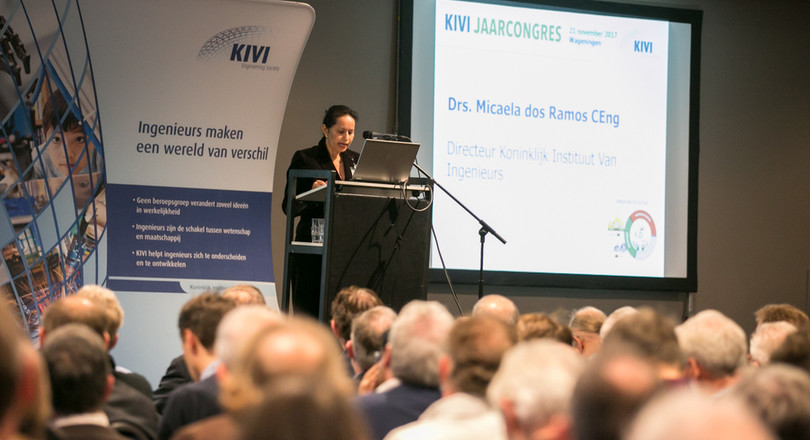
Engineers need to take a fresh new look at the impact of their work on the planet, according to KIVI Director Micaela dos Ramos, upon opening the engineering conference held this week in Wageningen.
It will not be the first time engineers have combated the harmful influence of human activities. That's why we have security systems, water purification plants, etc. However, we've now reached the point at which we cannot continue to deplete the resources available to us on this earth. We shall have to reach a new mind-set regarding our impact on the planet, and apply a holistic systemic vision when conducting our work.
This was the message with which KIVI director Micaela dos Ramos opened the engineering conference on circularity this morning, after which the various speakers elaborated on the subject.
Bio-based chemicals
Rector Magnificus and host Arthur Mol of Wageningen University gave a summary of the research into a new approach to (fossil) fuels, with a specific emphasis on the use of biomaterials. This includes conversion of waste materials from agriculture into a base product for the chemical industry or the more efficient use of valuable commodities such as phosphate, water and proteins, in order to limit the need for them. He also reported that Wageningen University has developed an online educational package (MOOC) in the field of bio-based chemicals.
Eva Gladek, CEO of the circular advisory and development agency Metabolic added her own observations. Analysis of the so-called Planetary Boundaries by the Stockholm Resilience Centre has shown that these boundaries are particularly being exceeded in terms of the biodiversity and biochemical make-up of the planet. She believes that rendering agriculture both circular and sustainable is of the highest priority, in the same way as for cities. She touched on the Ceuvel project in Amsterdam-Noord as an example of the latter. There, former canal houseboats have been renovated, plants purify the waste water and phosphates are reclaimed from urine. She concurred with Dos Ramos: Engineers, you create the world, but now need to recreate it using a fresh development model.
Attention for life-cycle
René Berkvens, CEO of shipbuilding and repairs company Damen Shipyards offered the ideal bridge from Gladek’s example regarding the conversion of canal boats. 'We've actually been doing that for many years, recommissioning ships.' This was one of the examples he gave on how his company is actually already circular, without the process being named as such. Where does that come from? 'Circularity and trade simply pair up excellently.' Berkvens also mentioned that his company has a unit which leases ships, a kind of water-borne sharing economy as it were. Damen has built a water taxi bus for an entrepreneur in Antwerp for example, who is uncertain whether the taxi will actually be a success. 'We designed the ship in such a manner that we can accept it back and recommission it.' Berkvens believes a favourable effect of leasing to be that his company needs to pay extra attention to the full life-cycle of a ship.
Marjan van Loon, President Director of Shell-Nederland, also learned lessons from her own company. 'We always believed that we needed to tackle the global climate problem at the global level. But that just doesn't work. Each country will follow its own course. The same applies to Shell, and that dynamic is clearly new territory for us as an international concern.'
Questions about CO2 storage
Another of her lessons learned is that engineers can devise the most fantastic solutions, but these will only work if they also enjoy political and social support. 'And so we need to involve other people in our solutions.' Her example of such a situation was the storage of CO2. 'Engineers can easily calculate why it is necessary and the fact that it is safe, but questions also arise: is such a solution not overly end-of-pipe and is it efficient?
Van Loon also advocated a more circular approach by engineers. 'Wind at sea is amazing, but how can we recycle it? The same applies to solar panels, for example. Re-use of scarce commodities is also part of the picture.'
During an Early Bird session, Dr. Margie Topp, lecturer at Windesheim University, also provided a good example of this, in which the glass fibre reinforced composite recycled from boats in this case, is now being re-used for the reinforcement of quaysides. With an added benefit: it lasts at least three times longer than the existing wooden reinforcement: 60 years instead of 20.
Newsletter
If you found this article interesting, then subscribe for free to our weekly newsletter.
Nieuwsbrief
Vond je dit een interessant artikel, abonneer je dan gratis op onze wekelijkse nieuwsbrief.

